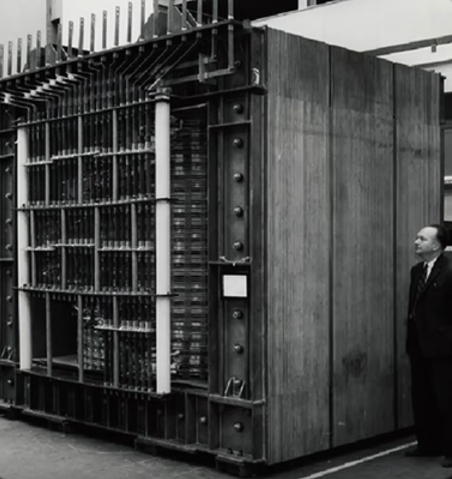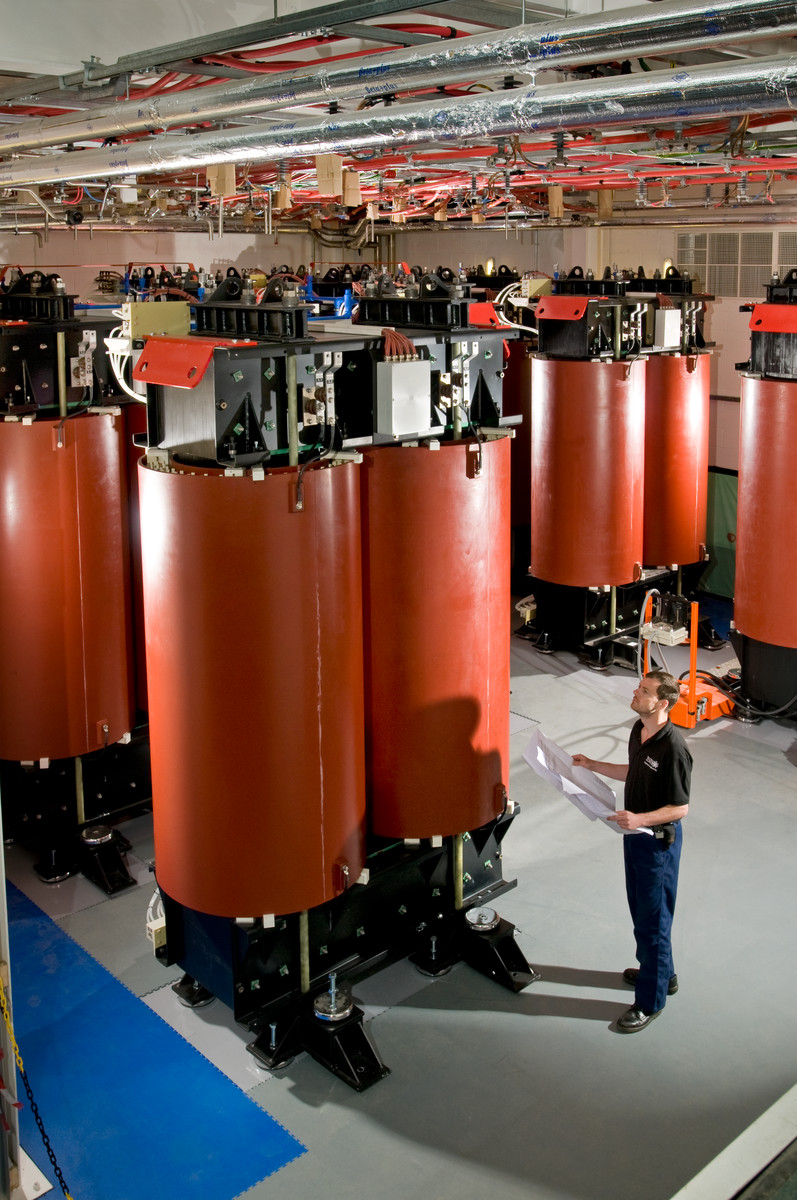Inside the ISIS accelerator, there are ten sets of magnets used for steering the protons and keeping them moving in the right direction. These are powered using a resonant circuit, where current oscillates back and forth along about 2.5km of cable allowing energy to move very quickly in and out of the magnets to match the acceleration cycle of the protons. The energy is stored in each oscillation as an electrical field in capacitors and a magnetic field in the chokes and magnets.

The electrical engineering team and others, mainly from ISIS Plant and Mechanical Sections, have been working on a long-term project to replace the choke system, which forms part of the magnet power supply to the accelerator in ISIS.
The original system has ten sections, each for a different section of the accelerator, integrated into one device (shown in photograph, right) and came to ISIS second hand. It was built during 1963‑65 for the NINA accelerator at the Daresbury laboratory, where it served for the ten year life-span of that machine. Adding its service at ISIS means that it has been in operation for more than 45 years.
"Although the system served us well, as it did the NINA synchrotron," explains electrical engineer Steve West; “it is
challenging to maintain and we don't know for certain what condition it is in. As NINA is built into a single unit, any failures would require the dismantling the whole 120-ton device to attempt repairs. The best estimate is that this would take at least 18 months, during which the whole of ISIS would be unable to run." As a
single point of failure this presented a significant risk to ISIS.
The project to replace the NINA choke has been going since 2004, taking years of research, design work and testing. The result is the Trench chokes – so named because of the primary manufacturer, Trench Austria GmbH. This system of twelve smaller separate chokes includes two spares on permanent standby that can be quickly put into service should one of the others fail.
"The development of this technology was very difficult, as it had to fit in with the existing infrastructure." Steve adds; “It didn't help that all those who worked on the original choke were well into their retirement, and that terminology changes meant that searching the literature was very difficult!"
Once the Trench chokes had been installed they needed to be tested and commissioned, and this required exclusive use of the synchrotron, meaning that it could not happen during a user cycle, machine physics work, or when there were people in the synchrotron hall – as there usually are during a shutdown. This led to a very long commissioning period with work mainly restricted to one or two evenings or nights allocated at the end of shutdown periods.

The Trench chokes (photograph, left) were first used for ISIS operations in February 2019. Steve explains; “The initial performance was encouraging; in terms of operating the machine and the physics no-one could really tell the difference – from our point of view, a very good result!"
Unfortunately, after six weeks of operation, one of the chokes failed and the system was switched back to NINA while investigations took place. ISIS staff, users and visitors would probably have seen the damaged choke while it stood out in R6 to be repaired. The choke turned out to have failed due to a small amount of debris that had become lodged in the winding – bridging the air-gap which normally withstands the high voltages present.
Despite the failure, being able to have six weeks of run time for the new system was very valuable: the team had not before been able to see the system working when fully warmed up. With the experience gained, and the cause of the fault determined, the goal now became to begin operating again during the cycle that was due start in September 2019 – at 800MeV.
The temporary break from operations allowed for some additional work to be done to improve the diagnostics systems that keep an eye on the 'health' of the choke system; most of this was carried out by ISIS Plant and SCADA sections: a small team led by Andy Sanders put in a lot of hours in the choke room to make it happen.
At the time of writing (April 2020) the Trench choke system has been used for two user-cycles at 800MeV, doing what they were originally designed to do. It has not been without incident, as there was a second choke failure. This time apparently caused by a stray nut somehow finding its way into one of the windings. With the new system including two spare chokes, one of these was switched into the circuit, enabling the completion of the user run, preventing the need to switch NINA back on again.
The source of the offending object has not been identified – it is not part of the choke itself. Steve explains that “while the incident is intensely frustrating, it is something of a relief that the fault was not caused by anything intrinsic to the choke itself."
The original plan had been to take the choke out for repair during the 2020 Easter shutdown; however, this was disrupted by the Covid-19 pandemic. Like a lot of things it will have to wait until the Steve and his team are back on site; “We are very keen not to have any more 'foreign object' damage, so regular inspections are being introduced to the choke maintenance schedule. Unfortunately, it takes something to go wrong before you know where to look and what to look for!"
“I enjoy working on a project that will have a long-term impact," says Steve; “I hate that so much of our technology becomes obsolete so quickly. The idea that the NINA choke was still going strong after 45 years of service is extremely impressive, and I would hope that this new system will last at least as long as ISIS, maybe being used for another facility when no longer needed here."
